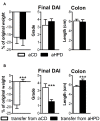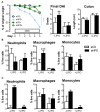Diet Rich in Animal Protein Promotes Pro-inflammatory Macrophage Response and Exacerbates Colitis in Mice
- PMID: 31105710
- PMCID: PMC6497971
- DOI: 10.3389/fimmu.2019.00919
Diet Rich in Animal Protein Promotes Pro-inflammatory Macrophage Response and Exacerbates Colitis in Mice
Abstract
Diet is a major factor determining gut microbiota composition and perturbances in this complex ecosystem are associated with the inflammatory bowel disease (IBD). Here, we used gnotobiotic approach to analyze, how interaction between diet rich in proteins and gut microbiota influences the sensitivity to intestinal inflammation in murine model of ulcerative colitis. We found that diet rich in animal protein (aHPD) exacerbates acute dextran sulfate sodium (DSS)-induced colitis while diet rich in plant protein (pHPD) does not. The deleterious effect of aHPD was also apparent in chronic DSS colitis and was associated with distinct changes in gut bacteria and fungi. Therefore, we induced acute DSS-colitis in germ-free mice and transferred gut microbiota from aCD or aHPD fed mice to find that this effect requires presence of microbes and aHPD at the same time. The aHPD did not change the number of regulatory T cells or Th17 cells and still worsened the colitis in immuno-deficient RAG2 knock-out mice suggesting that this effect was not dependent on adaptive immunity. The pro-inflammatory effect of aHPD was, however, abrogated when splenic macrophages were depleted with clodronate liposomes. This treatment prevented aHPD induced increase in colonic Ly-6Chigh pro-inflammatory monocytes, but the ratio of resident Ly-6C-/low macrophages was not changed. These data show that the interactions between dietary protein of animal origin and gut microbiota increase sensitivity to intestinal inflammation by promoting pro-inflammatory response of monocytes.
Keywords: colitis; dietary protein; germ-free; macrophage; microbiota.
Figures






Similar articles
-
Exopolysaccharide-Producing Bifidobacterium adolescentis Strains with Similar Adhesion Property Induce Differential Regulation of Inflammatory Immune Response in Treg/Th17 Axis of DSS-Colitis Mice.Nutrients. 2019 Apr 4;11(4):782. doi: 10.3390/nu11040782. Nutrients. 2019. PMID: 30987344 Free PMC article.
-
Interactions Between Diet and the Intestinal Microbiota Alter Intestinal Permeability and Colitis Severity in Mice.Gastroenterology. 2018 Mar;154(4):1037-1046.e2. doi: 10.1053/j.gastro.2017.11.030. Epub 2017 Nov 23. Gastroenterology. 2018. PMID: 29174952 Free PMC article.
-
Diet Rich in Simple Sugars Promotes Pro-Inflammatory Response via Gut Microbiota Alteration and TLR4 Signaling.Cells. 2020 Dec 16;9(12):2701. doi: 10.3390/cells9122701. Cells. 2020. PMID: 33339337 Free PMC article.
-
Intestinal Macrophages at the Crossroad between Diet, Inflammation, and Cancer.Int J Mol Sci. 2020 Jul 8;21(14):4825. doi: 10.3390/ijms21144825. Int J Mol Sci. 2020. PMID: 32650452 Free PMC article. Review.
-
Macrophages in intestinal homeostasis and inflammation.Immunol Rev. 2014 Jul;260(1):102-17. doi: 10.1111/imr.12192. Immunol Rev. 2014. PMID: 24942685 Free PMC article. Review.
Cited by
-
Fish Sidestream-Derived Protein Hydrolysates Suppress DSS-Induced Colitis by Modulating Intestinal Inflammation in Mice.Mar Drugs. 2021 May 28;19(6):312. doi: 10.3390/md19060312. Mar Drugs. 2021. PMID: 34071180 Free PMC article.
-
Loss of Gut Barrier Integrity In Lupus.Front Immunol. 2022 Jun 20;13:919792. doi: 10.3389/fimmu.2022.919792. eCollection 2022. Front Immunol. 2022. PMID: 35795671 Free PMC article. Review.
-
Calcium Oxalate Nephrolithiasis and Gut Microbiota: Not just a Gut-Kidney Axis. A Nutritional Perspective.Nutrients. 2020 Feb 20;12(2):548. doi: 10.3390/nu12020548. Nutrients. 2020. PMID: 32093202 Free PMC article. Review.
-
Mesenchymal Stromal Cells: New Generation Treatment of Inflammatory Bowel Disease.J Inflamm Res. 2024 May 22;17:3307-3334. doi: 10.2147/JIR.S458103. eCollection 2024. J Inflamm Res. 2024. PMID: 38800593 Free PMC article. Review.
-
Precision Dietary Intervention: Gut Microbiome and Meta-metabolome as Functional Readouts.Phenomics. 2025 Feb 14;5(1):23-50. doi: 10.1007/s43657-024-00193-7. eCollection 2025 Feb. Phenomics. 2025. PMID: 40313608 Review.
References
Publication types
MeSH terms
Substances
LinkOut - more resources
Full Text Sources
Medical

